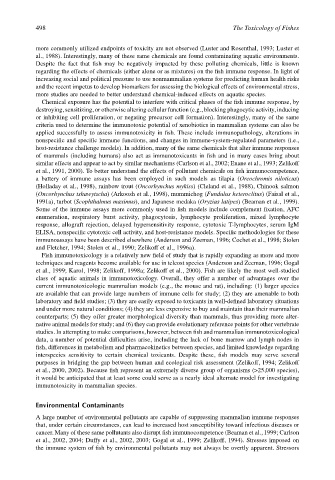Page 518 - The Toxicology of Fishes
P. 518
498 The Toxicology of Fishes
more commonly utilized endpoints of toxicity are not observed (Luster and Rosenthal, 1993; Luster et
al., 1988). Interestingly, many of these same chemicals are found contaminating aquatic environments.
Despite the fact that fish may be negatively impacted by these polluting chemicals, little is known
regarding the effects of chemicals (either alone or as mixtures) on the fish immune response. In light of
increasing social and political pressure to use nonmammalian systems for predicting human health risks
and the recent impetus to develop biomarkers for assessing the biological effects of environmental stress,
more studies are needed to better understand chemical-induced effects on aquatic species.
Chemical exposure has the potential to interfere with critical phases of the fish immune response, by
destroying, sensitizing, or otherwise altering cellular function (e.g., blocking phagocytic activity, inducing
or inhibiting cell proliferation, or negating precursor cell formation). Interestingly, many of the same
criteria used to determine the immunotoxic potential of xenobiotics in mammalian systems can also be
applied successfully to assess immunotoxicity in fish. These include immunopathology, alterations in
nonspecific and specific immune functions, and changes in immune-system-regulated parameters (i.e.,
host-resistance challenge models). In addition, many of the same chemicals that alter immune responses
of mammals (including humans) also act as immunotoxicants in fish and in many cases bring about
similar effects and appear to act by similar mechanisms (Carlson et al., 2002; Enane et al., 1993; Zelikoff
et al., 1991, 2000). To better understand the effects of pollutant chemicals on fish immunocompetence,
a battery of immune assays has been employed in such models as tilapia (Oreochromis niloticus)
(Holladay et al., 1998), rainbow trout (Oncorhynchus mykiss) (Cleland et al., 1988), Chinook salmon
(Oncorhynchus tshawytscha) (Arkoosh et al., 1998), mummichog (Fundulus heteroclitus) (Faisal et al.,
1991a), turbot (Scophthalmus maximus), and Japanese medaka (Oryzias latipes) (Beaman et al., 1999).
Some of the immune assays more commonly used in fish models include complement fixation, AFC
enumeration, respiratory burst activity, phagocytosis, lymphocyte proliferation, mixed lymphocyte
response, allograft rejection, delayed hypersensitivity response, cytotoxic T-lymphocytes, serum IgM
ELISA, nonspecific cytotoxic cell activity, and host-resistance models. Specific methodologies for these
immunoassays have been described elsewhere (Anderson and Zeeman, 1996; Cochet et al., 1998; Stolen
and Fletcher, 1994; Stolen et al., 1990; Zelikoff et al., 1996a).
Fish immunotoxicology is a relatively new field of study that is rapidly expanding as more and more
techniques and reagents become available for use in teleost species (Anderson and Zeeman, 1996; Gogal
et al., 1999; Karol, 1998; Zelikoff, 1998a; Zelikoff et al., 2000). Fish are likely the most well-studied
class of aquatic animals in immunotoxicology. Overall, they offer a number of advantages over the
current immunotoxicologic mammalian models (e.g., the mouse and rat), including: (1) larger species
are available that can provide large numbers of immune cells for study; (2) they are amenable to both
laboratory and field studies; (3) they are easily exposed to toxicants in well-defined laboratory situations
and under more natural conditions; (4) they are less expensive to buy and maintain than their mammalian
counterparts; (5) they offer greater morphological diversity than mammals, thus providing more alter-
native animal models for study; and (6) they can provide evolutionary reference points for other vertebrate
studies. In attempting to make comparisons, however, between fish and mammalian immunotoxicological
data, a number of potential difficulties arise, including the lack of bone marrow and lymph nodes in
fish, differences in metabolism and pharmacokinetics between species, and limited knowledge regarding
interspecies sensitivity to certain chemical toxicants. Despite these, fish models may serve several
purposes in bridging the gap between human and ecological risk assessment (Zelikoff, 1994; Zelikoff
et al., 2000, 2002). Because fish represent an extremely diverse group of organisms (>25,000 species),
it would be anticipated that at least some could serve as a nearly ideal alternate model for investigating
immunotoxicity in mammalian species.
Environmental Contaminants
A large number of environmental pollutants are capable of suppressing mammalian immune responses
that, under certain circumstances, can lead to increased host susceptibility toward infectious diseases or
cancer. Many of these same pollutants also disrupt fish immunocompetence (Beaman et al., 1999; Carlson
et al., 2002, 2004; Duffy et al., 2002, 2003; Gogal et al., 1999; Zelikoff, 1994). Stresses imposed on
the immune system of fish by environmental pollutants may not always be overtly apparent. Stressors

